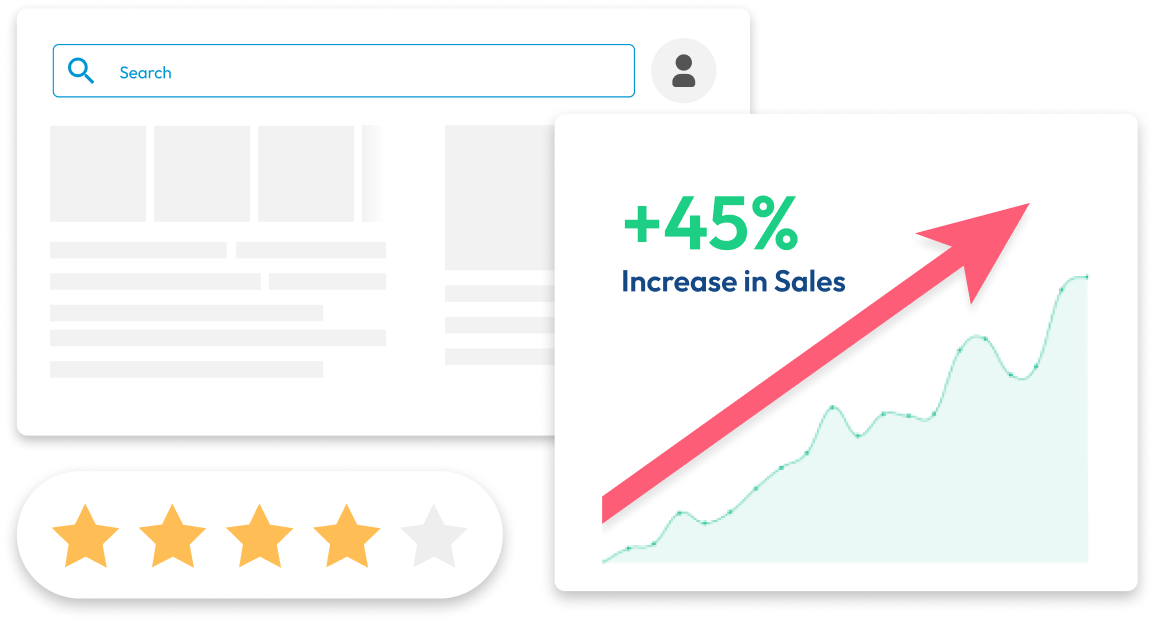Get a free consultation with us!
Stop wasting money and unlock the hidden potential of your advertising.
- Discover the power of intentional advertising
- Reach your ideal target audience.
- Maximize ad spend efficiency.

Pay-Per-Click (PPC) is an online advertising channel that puts your message directly in front of potential customers at the very moment they're searching for products or services like yours. Due to its unique blend of targeted visibility, measurable results, and budget control, it’s considered an essential component of any successful digital marketing strategy. In fact, studies have shown that businesses make an average of $2 in revenue for every $1 they spend on Google Ads (if done right). Now, you're probably already familiar with PPC - those sponsored results that appear at the top of search engine results pages (SERPs) or as eye-catching banners on your favourite websites. And maybe you’re wondering if this strategy could work for your business, or maybe you’ve already tried, but you feel like you aren’t quite squeezing every last drop of potential from your PPC campaigns. This beginner’s guide will shed some light on PPC advertising, exploring its intricacies and providing you with insights to maximise your ROI.
Stop wasting money and unlock the hidden potential of your advertising. Setting Up Your PPC Campaign Before launching a PPC campaign, you need to have a clear plan. Your campaign should look like a map guiding potential customers directly to your offerings. Each element of this plan should help the campaign be cost-effective and conversion-driven. Picking the right platform is crucial. Google Ads is a popular choice due to its massive search volume, but don't overlook other options like Bing or social media channels such as Facebook and Instagram. That said, the platform you choose should align with your target audience. For instance, B2B businesses may see better results on LinkedIn, while visual-centric brands might thrive on Instagram. Make sure your choice fits where your audience spends most of their time, as this increases the chance of engagement and clicks. Keyword research is the foundation of any online advertising and marketing campaign. Simply put, you need to understand the terms your audience is using to search for products or services like yours. Start by brainstorming keywords relevant to your offerings, then use tools like Google Keyword Planner or SEMrush to identify high-volume terms. Focus on a mix of broad, phrase, and exact match keywords to capture varied search intents. Prioritise long-tail keywords, as they tend to have lower competition and higher conversion rates. Targeting long-tail keywords could also make your ads stand out in voice search, which is an emerging trend. Your ad copy is the first impression potential customers get of your business. It needs to be clear, concise, and attention-grabbing. Start with a strong headline that speaks directly to the searcher's intent. Follow this with a description that highlights key benefits, features, or unique selling points. Use action-oriented language to prompt users to click, such as "Learn More" or "Get Started Now." Also, be sure to include your targeted keyword in the copy to improve relevance and ad quality scores. Remember to read up on industry best practices for your chosen platform. Moreover, each platform has guidelines like character count, image size, etc., so be sure to follow them all. Managing your PPC budget is about balancing cost and results. Start by determining how much you can allocate daily or monthly and how much you're willing to spend per click (CPC). Tools like Google Ads' bid strategies (e.g., manual CPC or automated bidding) can help you optimise your ad spend. Focus on maximising your return on investment by tracking your performance regularly and adjusting bids for high-performing keywords. Don't forget to allocate a portion of your budget for testing new keywords or ad variations to improve future results.
Optimising Your PPC Campaign Once your pay-per-click campaign is up and running, the next step is ongoing optimisation. This is where you fine-tune every aspect of your campaign to maximise performance and increase ROI. From testing different ad versions to improving your Quality Score, effective PPC optimisation ensures your ads reach the right audience at the right time while keeping costs down. A/B testing is an essential method for improving your campaigns. By creating two or more variations of an ad, you can test different elements like headlines, descriptions, calls-to-action, or even display URLs. One version might resonate better with your audience, leading to higher click-through rates (CTR) and conversions. Start by making small changes, and ensure you're only testing one variable at a time to accurately measure the impact. Over time, A/B testing helps you refine your messaging and design, ultimately leading to a more effective pay-per-click strategy. The Quality Score is Google’s rating of your ad relevance, click-through rate, and landing page quality. Improving this score is a key aspect of PPC optimisation because a higher score means lower costs and better ad placements. To enhance your Quality Score, focus on creating highly relevant ads aligned with your target keywords. Also, make sure your landing page matches the ad copy and provides a seamless user experience. Regularly updating your keyword lists and refining your ads will help maintain a strong Quality Score, maximising the effectiveness of your PPC efforts. Ad extensions are powerful tools for boosting the visibility and clickability of your ads. They allow you to add extra information, such as phone numbers, site links, or additional callouts, making your ad more compelling and relevant to users. Using ad extensions not only enhances the overall user experience but also contributes to a higher Quality Score and lower cost-per-click. Implementing extensions like location, call, and structured snippets can significantly improve the performance of your pay-per-click campaigns by providing more context and options for potential customers to engage with your brand. Tracking and Measuring Success Monitoring key performance metrics helps you assess whether your ads are reaching the right audience and driving valuable traffic. Measuring success also enables you to make informed adjustments for better campaign performance. When it comes to PPC campaigns, certain metrics provide crucial insights into your performance. Among them are: Click-through rate (CTR): Measures how compelling your ad is by tracking the percentage of people who click on your ad after seeing it. Conversion rate: Shows how many clicks result in desired actions, like purchases or sign-ups. Cost-per-click (CPC): Reflects the average cost you pay each time someone clicks on your ad. Cost-per-acquisition (CPA): Helps gauge the efficiency of your spend by calculating the cost of acquiring a customer. Impressions: Reveal how often your ad is displayed, providing insight into its visibility. Monitoring these key PPC metrics consistently allows you to track your campaign’s health, identify areas of improvement, and make sure your budget is working effectively. To get the most from PPC optimisation, you need to dive deep into performance data. Start by evaluating how different keywords, ad variations, and audiences perform. Use tools like Google Analytics or your ad platform’s reporting features to see where users drop off or which keywords drive the most conversions. Review trends over time to understand which elements of your campaign are contributing to success and which need refinement. By consistently examining your data, you’ll uncover insights that can help you make targeted adjustments and improve overall PPC performance. Effective PPC optimisation is driven by data. Once you’ve analysed the metrics, the next step is to use that information to make informed decisions. If certain keywords consistently underperform, allocate your budget to those that deliver better results. Similarly, if a specific ad format is yielding more conversions, focus your efforts there. Data-driven decisions not only improve campaign efficiency but also allow you to allocate resources where they’ll have the most impact. This continuous process ensures your pay-per-click campaigns are always evolving based on real-time insights. Common PPC Mistakes to Avoid Launching a successful pay-per-click campaign requires careful planning and continuous monitoring. However, even the best campaigns can fail if pitfalls are overlooked. Knowing what to avoid is just as important as knowing what to do. Negative keywords prevent your ads from being shown to irrelevant audiences. Failing to include them can result in wasted budget by showing your ads for searches that don’t align with your business. For example, if you sell premium products, you might want to exclude searches containing terms like "cheap" or "free." Regularly updating your negative keyword list helps ensure your ads only reach high-intent users, keeping your PPC spend efficient and your targeting sharp. With mobile traffic now accounting for a huge portion of online searches, ignoring mobile users in your strategy is a costly mistake. Mobile users tend to behave differently, often looking for quick, concise information. Make sure your ads and landing pages are optimised for mobile, including fast loading times, easy navigation, and mobile-specific ad copy. Also, consider adjusting your bids for mobile to capture this valuable audience. By tailoring your campaign to mobile users, you can improve your chances of capturing leads and conversions from this growing segment. A successful PPC campaign isn’t just about clicks - it’s about driving meaningful actions, like purchases or sign-ups. Without conversion tracking, you have no way of knowing whether your campaign is actually generating results. Set up conversion tracking on platforms like Google Ads to monitor actions taken after users click your ad. Whether it’s form submissions, product purchases, or newsletter sign-ups, tracking conversions allows you to measure ROI accurately and make informed decisions about your campaign’s performance. As the digital landscape evolves, so too does PPC advertising. AI and machine learning are revolutionising this channel by automating bid adjustments and optimising ad placements in real-time. Voice search is becoming a bigger player in the game, meaning businesses will need to adapt their keyword strategies accordingly. To top it off, privacy regulations and cookie restrictions are pushing advertisers to rethink how they track and target users. Staying ahead of these trends is crucial for keeping your campaigns relevant and effective. PPC, or any digital marketing strategy, for that matter, is not a set-and-forget practice. It requires constant monitoring, learning, and adapting to the latest changes. Whether it’s refining your ad copy, testing new keywords, or optimising for mobile users, the most successful PPC campaigns evolve with time. The ability to pivot based on data insights, performance metrics, and market shifts is key to long-term success in pay-per-click advertising. Navigating the intricate reality of PPC can be challenging, but with the right strategy and ongoing optimisation, the rewards can be significant. As future trends emerge and the digital marketing space shifts, continuous learning and adaptation are critical to staying competitive. At Xugar, we specialise in crafting and managing PPC campaigns that deliver measurable results. With expertise honed over decades of experience and the best tools in the trade, we handle everything from strategy development to ongoing optimisation, so you get the best return on your ad spend. Let us take the hassle out of PPC for you. Contact Xugar today and let’s drive your business growth together.Get a free consultation with us!

Choosing the Right Platform
Keyword Research
Writing Effective Ad Copy
Setting Budgets and Bids
A/B Testing
Quality Score Improvement
Ad Extensions
Key Metrics to Monitor
Analysing Performance Data
Making Data-Driven Decisions
Overlooking Negative Keywords
Ignoring Mobile Users
Failing to Track Conversions
Future Trends in online advertising
Continuous Learning and Adaptation
Bringing It All Together





WINNER

FINALIST

FINALIST

WINNER

WINNER

FINALIST

FINALIST

WINNER
